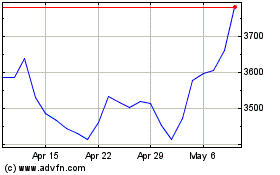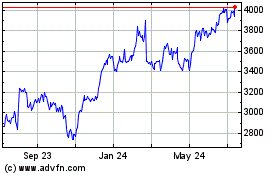By Jason Zweig
Stock splits are going extinct.
So far in 2016, only five companies in the S&P 500 stock
index -- and only 63 among more than 10,100 U.S. companies tracked
by S&P Dow Jones Indices -- have split their shares. This year
is on track to be the third-lowest for stock splits in modern
history, behind only 2009 and 2010, when companies were too
traumatized by the financial crisis to dare lowering their share
prices.
Share prices that look like typographical errors -- Berkshire
Hathaway's, around $217,000; NVR, the home builder, around $1,640;
Priceline Group, about $1,470; Alphabet, the parent of Google, over
$800 -- are becoming the norm. The days of giving 100 shares of
stock as a confirmation or bar mitzvah or graduation gift may be
doomed.
But I am not here to lament the demise of the stock split. In
fact, that is good news. It is a sign that the investing world may
finally be learning the distinction between the price of a stock
and the value of a business.
In a typical 2-for-1 split, a company doubles the number of its
shares outstanding while halving the per-share price. That is the
stock-market equivalent of exchanging one dime for two nickels. You
end up holding twice as many units each worth half its former
price. You would be foolish to think that makes you richer.
Back in the days when stock tickers went clickety-clack and
stockbrokers were human beings rather than websites, it was cheaper
to trade in "round lots" of 100 shares than "odd lots" of less than
100.
And during the internet bubble, companies with levitating stock
prices could get another boost just by announcing a stock split,
which traders erroneously regarded as a sure sign of future
gains.
But today, online discount brokers such as Fidelity Investments
or Charles Schwab charge commissions of less than $10 a trade
regardless of how much stock you buy or what the share price
happens to be.
As companies stop splitting, the average price of an S&P 500
stock, according to Credit Suisse, has risen to a near-record $86 a
share -- after decades of remaining in a range between $25 and $45.
(Adjusted for inflation, average share prices fell by more than 90%
between 1933 and 2007 -- a trend that has sharply reversed since.)
The average share price of companies in the small-stock Russell
2000 index, by contrast, has risen only to about $29.
Index funds, those autopilot portfolios that are run to minimize
costs, own proportionately more of large stocks than small
stocks.
Unlike individuals, funds generally pay commissions based partly
on how many shares they trade, so it is generally more expensive
for funds to buy and sell a stock after it splits. These big funds,
not individuals, are the investors most companies cater to
nowadays.
Some still say that splitting is a signal of good health.
When Louisville, Ky., beverage company Brown-Forman announced a
2-for-1 split in May, its chief executive, Paul Varga, said the
move "reflects the company's confidence in our ability to
sustainably grow our sales, earnings and cash flow over the long
term."
"There's no compelling business case to doing it," says Robert
M. Knight Jr., chief financial officer of Omaha-based Union
Pacific, which last split, 2-for-1, in 2014. "It's more of a feel,
kind of a subtle message of confidence that maybe your stock is
going to continue to rise."
But even that sort of ambivalent support is dwindling.
Home Depot split its stock in eight of the 11 years from 1989
through 1999, cumulatively turning each one of its shares into more
than 30. It hasn't done a split since and has no plans to do
another, says its head of investor relations, Diane Dayhoff.
A split "wouldn't change the intrinsic value of the company and
doesn't provide any real benefit," Ms. Dayhoff says, while
administrative and registration costs would likely run into the
hundreds of thousands of dollars. "We have to sell a lot of hammers
to make that up," she says.
Thomas Gayner is co-chief executive of Markel, an insurance
company whose share price brushed $930 this past week. "If you and
I together bought some commercial real estate for $1 million," he
asks, "would it matter whether we divided it so we each held one
share at $500,000 apiece or 500 shares at $1,000 apiece?"
He adds, "we want shareholders who focus on the investment
itself, rather than on the currency it's denominated in."
Even Mr. Gayner admits, though, that a high stock price still
has a vestigial allure. If Markel goes above $1,000 a share, he
says, "I'll probably take my wife out to dinner." Then, catching
himself, he adds with a laugh: "But I won't use Markel stock to pay
for it."
(END) Dow Jones Newswires
October 01, 2016 02:47 ET (06:47 GMT)
Copyright (c) 2016 Dow Jones & Company, Inc.
Booking (NASDAQ:BKNG)
Historical Stock Chart
From Mar 2024 to Apr 2024

Booking (NASDAQ:BKNG)
Historical Stock Chart
From Apr 2023 to Apr 2024
